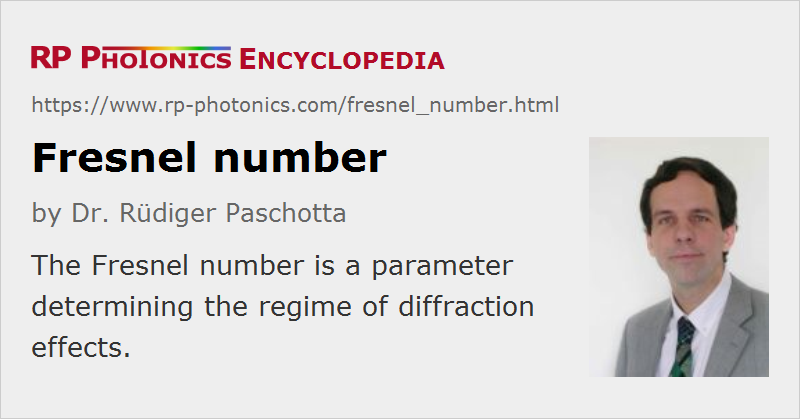Fresnel Number
Definition: a parameter determining the regime of diffraction effects
German: Fresnel-Zahl
Categories: general optics, optical resonators
How to cite the article; suggest additional literature
Author: Dr. Rüdiger Paschotta
Originally, the Fresnel number was introduced in the context of diffraction theory for beam propagation. If a light wave first passes through an aperture of size (e.g. radius) a and then propagates over a distance L to a screen, the situation is characterized with the Fresnel number
where λ is the wavelength.
For values of the Fresnel number well below 1, Fraunhofer diffraction occurs where the screen essentially shows the far-field diffraction pattern of the aperture, which is closely related to the spatial Fourier transform of the complex amplitude distribution of the light field after the aperture.
Fresnel numbers around 1 or larger characterize the situation of Fresnel diffraction (or near-field diffraction), where the mathematical description is more complicated. For not too large Fresnel numbers and diffraction angles, the Fresnel approximation can be used.
Fresnel Number of a Resonator
The concept of the Fresnel number has also been applied to optical resonators (cavities), in particular to laser resonators [1]. One again uses the equation
where a is now the radius of the end mirrors, and L is the resonator length.
A large Fresnel number (well above 1) of a resonator (cavity) means that diffraction losses at the end mirrors are small for typical mode sizes (i.e. not near a stability limit of the resonator, where mode sizes can diverge). This is the usual situation in a stable laser resonator. Conversely, a small Fresnel number means that diffraction losses can be significant – particularly for higher-order modes, so that diffraction-limited operation may be favored.
Most stable laser resonators have a fairly large Fresnel number, whereas small Fresnel numbers occur in unstable resonators, which are sometimes applied in high-power lasers.
The Fresnel number is also important for the analysis of the modes of (plane) Fabry–Pérot interferometers, which extend to the edges of the mirrors.
Questions and Comments from Users
Here you can submit questions and comments. As far as they get accepted by the author, they will appear above this paragraph together with the author’s answer. The author will decide on acceptance based on certain criteria. Essentially, the issue must be of sufficiently broad interest.
Please do not enter personal data here; we would otherwise delete it soon. (See also our privacy declaration.) If you wish to receive personal feedback or consultancy from the author, please contact him e.g. via e-mail.
By submitting the information, you give your consent to the potential publication of your inputs on our website according to our rules. (If you later retract your consent, we will delete those inputs.) As your inputs are first reviewed by the author, they may be published with some delay.
Bibliography
| [1] | A. E. Siegman, Lasers, University Science Books, Mill Valley, CA (1986) |
See also: optical resonators, laser resonators, Fabry–Pérot interferometers
and other articles in the categories general optics, optical resonators
 |



If you like this page, please share the link with your friends and colleagues, e.g. via social media:
These sharing buttons are implemented in a privacy-friendly way!